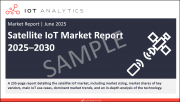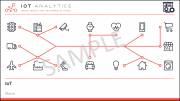
|
시장보고서
상품코드
1530532
위성 IoT 시장 규모, 점유율, 동향 분석 보고서 : 서비스별, 최종 용도별, 조직 규모별, 지역별, 부문별 예측(2024-2030년)Satellite IoT Market Size, Share & Trends Analysis Report By Service (Direct to Satellite, IoT Satellite Backhaul), By End-use (Defense, Energy & Utilities), By Organization Size, By Region, And Segment Forecasts, 2024 - 2030 |
||||||
위성 IoT 시장 규모와 동향
세계 위성 IoT 시장 규모는 2023년 11억 2,000만 달러로 추정되며, 2024-2030년까지 연평균 14.6%의 성장률을 보일 것으로 예상됩니다. 농업, 운송, 에너지 등 다양한 산업 분야에서 IoT 활용이 확산되고 있는 것이 시장 성장의 주요 요인으로 작용하고 있습니다. 이들 부문은 업무 모니터링, 제어 및 최적화를 위해 IoT 기기에 대한 의존도가 높아지고 있습니다. 위성 IoT는 지상 네트워크를 사용할 수 없거나 신뢰할 수 없는 원격지 및 서비스 취약 지역에서의 연결성을 설명합니다. 이 기능은 원활한 데이터 전송과 장치 관리를 가능하게 하여 지속적인 운영과 효율을 향상시켜 시장 성장을 촉진할 수 있습니다.
또한, 저궤도(LEO) 위성의 개발 등 위성 통신의 기술 발전으로 인해 시장도 큰 혜택을 누리고 있으며, LEO 위성은 기존 정지위성에 비해 광대역, 저지연 통신을 제공할 수 있습니다. 이러한 서비스 품질 향상으로 위성 IoT 솔루션은 실시간 자산 추적, 고속 데이터 전송 등 다양한 응용 분야에서 더욱 매력적이어서 시장 성장을 견인하고 있습니다.
전 세계 정부 및 국방 기관은 안전하고 신뢰할 수 있는 통신, 항법 및 감시를 위해 위성 기술에 광범위하게 의존하고 있습니다. 국가 안보 인프라 강화에 대한 관심이 높아지면서 다양한 군사 작전과 프로젝트를 지원하는 위성 IoT 기술에 대한 수요가 급증하고 있습니다. 이러한 노력은 위성 통신을 통한 견고하고 안전한 페일프루프(fail-proof) 연결성을 필요로 하며, 이는 시장 확대의 원동력이 되고 있습니다.
또한, 산업 전반의 디지털 전환과 자동화를 향한 전 세계적인 움직임으로 인해 IoT 도입이 급증하고 있습니다. 위성 IoT는 기존의 연결 방식이 작동하기 어려운 열악한 환경이나 원격지에 있는 IoT 장치를 연결하는 데 중요한 역할을 하고 있습니다. 이러한 IoT 솔루션의 광범위한 채택은 원활한 세계 커버리지를 보장하기 위해 위성 기술의 통합을 필요로 하며, 이는 향후 몇 년 동안 시장 성장을 촉진할 것입니다.
또한, 산업 전반에 걸쳐 데이터 기반 의사결정이 급증하면서 위성 IoT에 대한 수요가 급증하고 있습니다. 기업들은 IoT 데이터를 활용하여 인사이트를 높이고, 프로세스를 최적화하며, 운영 효율성을 높이고 있습니다. 위성 IoT는 원격지 및 모바일 자산에서 중요한 데이터를 수집하고 전송하여 의사결정자가 실시간 정보에 접근할 수 있도록 지원합니다. 이 기능은 예지보전, 자산 추적, 환경 모니터링 및 기타 용도을 지원하여 시장을 발전시킬 수 있습니다.
세계 위성 IoT 시장 보고서 세분화
이 보고서는 2018년부터 2030년까지 각 하위 부문의 최신 시장 동향과 기회 분석과 함께 세계, 지역 및 국가별 수익 성장을 추정 및 예측합니다. 이 조사에서 Grand View Research, Inc.는 조직 규모, 서비스, 최종 용도 및 지역에 따라 세계 위성 IoT 시장 보고서를 세분화했습니다.
목차
제1장 조사 방법과 범위
제2장 주요 요약
제3장 위성 IoT 시장 - 업계 전망
- 시장 개요
- 업계 밸류체인 분석
- 시장 역학
- 기술 상황
- 업계 분석 툴
제4장 위성 IoT 시장 : 조직 규모, 추정·동향 분석
- 조직 규모 변동 분석과 시장 점유율, 2023년과 2030년
- 조직 규모별, 2018-2030년
제5장 위성 IoT 시장 : 서비스, 추정·동향 분석
- 서비스 변동 분석과 시장 점유율, 2023년과 2030년
- 서비스별, 2018-2030년
제6장 위성 IoT 시장 : 최종 용도, 추정·동향 분석
- 최종 용도 변동 분석과 시장 점유율, 2023년과 2030년
- 용도별, 2018-2030년
제7장 지역별, 추정·동향 분석
- 지역별 위성 IoT 시장, 2023년과 2030년
- 북미
- 북미의 위성 IoT 시장 추정과 예측, 2018-2030년,
- 미국
- 캐나다
- 멕시코
- 유럽
- 유럽의 위성 IoT 시장 추정과 예측, 2018-2030년,
- 독일
- 영국
- 프랑스
- 이탈리아
- 아시아태평양
- 아시아태평양의 위성 IoT 시장 추정과 예측, 2018-2030년,
- 일본
- 중국
- 인도
- 한국
- 호주
- 라틴아메리카
- 라틴아메리카의 위성 IoT 시장 추정과 예측, 2018-2030년,
- 브라질
- 중동 및 아프리카
- 중동 및 아프리카의 위성 IoT 시장 추정과 예측, 2018-2030년,
- 사우디아라비아
- 아랍에미리트
- 남아프리카공화국
제8장 위성 IoT 시장 - 경쟁 상황
- 주요 시장 진출 기업의 최근 동향과 영향 분석
- 기업 분류
- 진출 기업 개요
- 기업의 시장 포지셔닝
- 기업 히트맵 분석
- 전략 매핑
- 확대/매각
- 협업/파트너십
- 신제품 발매
- 연구개발
- 기업 개요
- Iridium Satellite LLC
- ORBCOMM Inc.
- Globalstar, Inc.
- Northrop Grumman Corporation
- Swarm Technologies Inc.
- Inmarsat Group
- Kepler Communications Inc.
- Myriota Pty Ltd.
- Thales SA
- Airbus SE
Satellite IoT Market Size & Trends
The global satellite IoT market size was estimated at USD 1.12 billion in 2023 and is expected to grow at a CAGR of 14.6% from 2024 to 2030. The proliferation of IoT applications across various industries, such as agriculture, transportation, and energy, is a significant market growth driver. These sectors increasingly rely on IoT devices to monitor, control, and optimize operations. Satellite IoT provides connectivity in remote and underserved areas where terrestrial networks are unavailable or unreliable. This capability enables seamless data transmission and device management, ensuring continuous operation and improving efficiency, thereby driving market growth.
Moreover, the market is benefiting significantly from technological advancements in satellite communications, such as the development of low-earth orbit (LEO) satellites. LEO satellites can provide higher bandwidth and lower latency communications compared to traditional geostationary satellites. This improvement in the quality of service makes satellite IoT solutions more attractive for a wide range of applications, including real-time asset tracking and high-speed data transmission, fueling market growth.
Governments and defense agencies across the globe rely extensively on satellite technology for secure and reliable communication, navigation, and surveillance. With an increasing focus on enhancing national security infrastructure, there is a surge in demand for satellite IoT technologies to support various military operations and projects. These initiatives require robust, secure, and fail-proof connectivity fulfilled by satellite communications, thus driving market expansion.
In addition, the global drive towards digital transformation and automation across industries has led to a surge in IoT adoption. Satellite IoT plays a crucial role in enabling connectivity for IoT devices located in harsh or remote environments where traditional connectivity methods are difficult to function. This widespread adoption of IoT solutions necessitates the integration of satellite technology to ensure seamless global coverage, thereby propelling market growth in the coming years.
Furthermore, the surge in data-driven decision-making practices across industries propels the demand for Satellite IoT. Organizations leverage IoT data to gain insights, optimize processes, and enhance operational efficiency. Satellite IoT enables the collection and transmission of critical data from remote or mobile assets, ensuring decision-makers can access real-time information. This capability supports predictive maintenance, asset tracking, environmental monitoring, and other applications, propelling the market forward.
Global Satellite IoT Market Report Segmentation
This report forecasts and estimates revenue growth at the global, regional, and country levels along with analyzes the latest market trends and opportunities in each one of the sub-segments from 2018 to 2030. For this study, Grand View Research has further segmented the global satellite IoT market report based on organization size, service, end-use, and region:
- Organization Size Outlook (Revenue, USD Million, 2018 - 2030)
- Large Enterprises
- Small & Medium Sized Enterprises
- Service Outlook (Revenue, USD Million, 2018 - 2030)
- Direct to Satellite
- IoT Satellite Backhaul
- End-use Mode Outlook (Revenue, USD Million, 2018 - 2030)
- Defense
- Energy & Utilities
- Agriculture
- Environmental
- Transport and Logistics
- Marine
- Others
- Regional Outlook (Revenue, USD Million, 2018 - 2030)
- North America
U.S.
Canada
Mexico
- Europe
Germany
UK
France
Italy
- Asia Pacific
Japan
China
India
Australia
South Korea
- Latin America
Brazil
- Middle East and Africa (MEA)
UAE
Saudi Arabia
South Africa
Table of Contents
Chapter 1. Methodology and Scope
- 1.1. Market Segmentation & Scope
- 1.2. Market Definitions
- 1.3. Information Procurement
- 1.3.1. Information analysis
- 1.3.2. Market formulation & data visualization
- 1.3.3. Data validation & publishing
- 1.4. 4 Research Scope and Assumptions
- 1.4.1. List of Data Sources
Chapter 2. Executive Summary
- 2.1. Satellite IoT Market Snapshot
- 2.2. Satellite IoT Market- Segment Snapshot (1/2)
- 2.3. Satellite IoT Market- Segment Snapshot (2/2)
- 2.4. Satellite IoT Market- Competitive Landscape Snapshot
Chapter 3. Satellite IoT Market - Industry Outlook
- 3.1. Market Overview
- 3.2. Industry Value Chain Analysis
- 3.3. Market Dynamics
- 3.3.1. Market Driver Analysis
- 3.3.2. Market Restraint Analysis
- 3.3.3. Market Opportunity
- 3.4. Technology Landscape
- 3.5. Industry Analysis Tools
- 3.5.1. Porter's analysis
- 3.5.2. Macroeconomic analysis
Chapter 4. Satellite IoT Market: Organization Size Estimates & Trend Analysis
- 4.1. Organization Size Movement Analysis & Market Share, 2023 & 2030
- 4.2. Satellite IoT Market Estimates & Forecast, By Organization Size, 2018 - 2030 (USD Million)
- 4.2.1. Large Enterprises
- 4.2.2. Small & Medium Sized Enterprises
Chapter 5. Satellite IoT Market: Service Estimates & Trend Analysis
- 5.1. Service Movement Analysis & Market Share, 2023 & 2030
- 5.2. Satellite IoT Market Estimates & Forecast, By Service 2018 - 2030 (USD Million)
- 5.2.1. Direct to Satellite
- 5.2.2. IoT Satellite Backhaul
Chapter 6. Satellite IoT Market: End Use Estimates & Trend Analysis
- 6.1. End Use Movement Analysis & Market Share, 2023 & 2030
- 6.2. Satellite IoT Market Estimates & Forecast, By End Use 2018 - 2030 (USD Million)
- 6.2.1. Defense
- 6.2.2. Energy & Utilities
- 6.2.3. Agriculture
- 6.2.4. Environmental
- 6.2.5. Transport and Logistics
- 6.2.6. Marine
- 6.2.7. Others
Chapter 7. Regional Estimates & Trend Analysis
- 7.1. Satellite IoT Market by Region, 2023 & 2030
- 7.2. North America
- 7.2.1. North America Satellite IoT Market Estimates & Forecasts, 2018 - 2030, (USD Million)
- 7.2.2. U.S.
- 7.2.3. Canada
- 7.2.4. Mexico
- 7.3. Europe
- 7.3.1. Europe Satellite IoT Market Estimates & Forecasts, 2018 - 2030, (USD Million)
- 7.3.2. Germany
- 7.3.3. UK
- 7.3.4. France
- 7.3.5. Italy
- 7.4. Asia Pacific
- 7.4.1. Asia Pacific Satellite IoT Market Estimates & Forecasts, 2018 - 2030, (USD Million)
- 7.4.2. Japan
- 7.4.3. China
- 7.4.4. India
- 7.4.5. South Korea
- 7.4.6. Australia
- 7.5. Latin America
- 7.5.1. Latin America Satellite IoT Market Estimates & Forecasts, 2018 - 2030, (USD Million)
- 7.5.2. Brazil
- 7.6. Middle East & Africa (MEA)
- 7.6.1. MEA Satellite IoT Market Estimates & Forecasts, 2018 - 2030, (USD Million)
- 7.6.2. Saudi Arabia
- 7.6.3. UAE
- 7.6.4. South Africa
Chapter 8. Satellite IoT Market - Competitive Landscape
- 8.1. Recent Developments & Impact Analysis, By Key Market Participants
- 8.2. Company Categorization
- 8.3. Participant's Overview
- 8.4. Financial Performance
- 8.5. Product Benchmarking
- 8.6. Company Market Positioning
- 8.7. Company Heat Map Analysis
- 8.8. Strategy Mapping
- 8.8.1. Expansion/Divestiture
- 8.8.2. Collaborations/Partnerships
- 8.8.3. New Product Launches
- 8.8.4. Research & Development
- 8.9. Company Profiles
- 8.9.1. Iridium Satellite LLC
- 8.9.1.1. Participant's Overview
- 8.9.1.2. Financial Performance
- 8.9.1.3. Product Benchmarking
- 8.9.1.4. Recent Developments
- 8.9.2. ORBCOMM Inc.
- 8.9.2.1. Participant's Overview
- 8.9.2.2. Financial Performance
- 8.9.2.3. Product Benchmarking
- 8.9.2.4. Recent Developments
- 8.9.3. Globalstar, Inc.
- 8.9.3.1. Participant's Overview
- 8.9.3.2. Financial Performance
- 8.9.3.3. Product Benchmarking
- 8.9.3.4. Recent Developments
- 8.9.4. Northrop Grumman Corporation
- 8.9.4.1. Participant's Overview
- 8.9.4.2. Financial Performance
- 8.9.4.3. Product Benchmarking
- 8.9.4.4. Recent Developments
- 8.9.5. Swarm Technologies Inc.
- 8.9.5.1. Participant's Overview
- 8.9.5.2. Financial Performance
- 8.9.5.3. Product Benchmarking
- 8.9.5.4. Recent Developments
- 8.9.6. Inmarsat Group
- 8.9.6.1. Participant's Overview
- 8.9.6.2. Financial Performance
- 8.9.6.3. Product Benchmarking
- 8.9.6.4. Recent Developments
- 8.9.7. Kepler Communications Inc.
- 8.9.7.1. Participant's Overview
- 8.9.7.2. Financial Performance
- 8.9.7.3. Product Benchmarking
- 8.9.7.4. Recent Developmentserformance
- 8.9.10.3. Product Benchmarking
- 8.9.10.4. Recent
- 8.9.8. Myriota Pty Ltd.
- 8.9.8.1. Participant's Overview
- 8.9.8.2. Financial Performance
- 8.9.8.3. Product Benchmarking
- 8.9.8.4. Recent Developments
- 8.9.9. Thales S.A.
- 8.9.9.1. Participant's Overview
- 8.9.9.2. Financial Performance
- 8.9.9.3. Product Benchmarking
- 8.9.9.4. Recent Developments
- 8.9.10. Airbus SE
- 8.9.10.1. Participant's Overview
- 8.9.10.2. Financial PDevelopments
- 8.9.1. Iridium Satellite LLC
(주말 및 공휴일 제외)


















